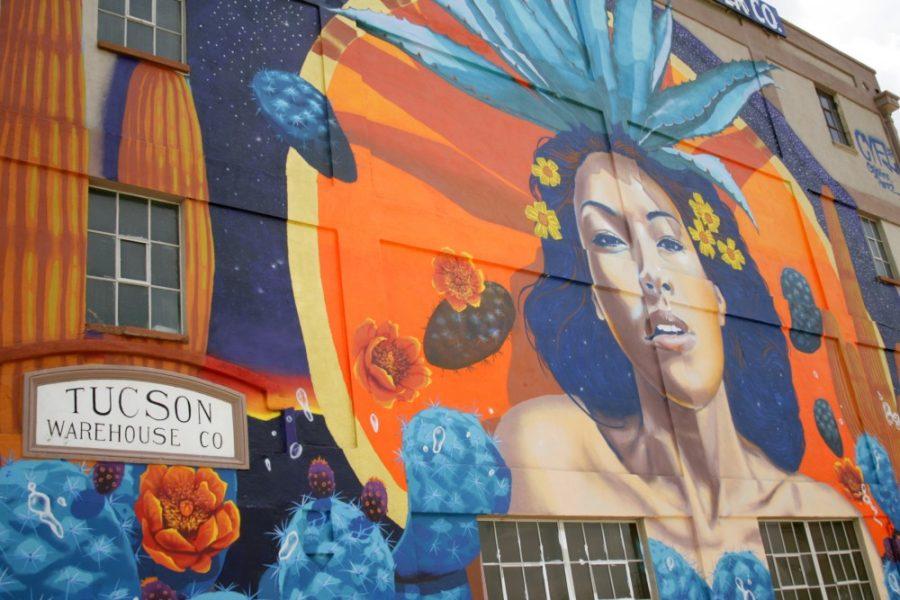Tucked between the Southern Pacific Railroad and Sixth Street sits a collection of old warehouse buildings speckled with creative signs and street art. The area, called the Warehouse Arts District, is Tucson’s only designated arts district.
Santa Theresa Tile Works, one of the district’s many studios, is hidden in the back of one of the warehouses off of Sixth Avenue. The small entrance opens up into a storefront and leads into a vast open space in the back. Several artists work on their own ceramic tile art while studio owner Susan Gamble helps a customer choose the right tile-making products.
“I have a different style of doing things—non-artists can come in and create a piece of art on their own,” Gamble said. “I want to give them access to the arts world—an experience, the process of creating something.”
Gamble started working as an artist in Tucson 30 years ago in a dilapidated adobe building—it had holes in the ground, but it was “affordable.” She decided to move her studio to the Warehouse Arts District back in 1998.
Since moving to the district, Gamble has worked to foster a sense of community among local artists and patrons. She said the area’s affordable rent allowed her to live and work comfortably as an artist.
RELATED: Wooden Tooth Records finds new home downtown
Arts districts around the country function to offer artists affordable access to facilities where they can create and sell their works. The problem that eventually arises in many of these artistic enclaves is a debated issue of the ages — gentrification, a process where wealthier people move into and develop poorer areas, which simultaneously drives up property prices and displaces the area’s poor residents.
Similar to Tucson, downtown Phoenix’sarts community has flourished in recent years, largely thanks to downtown cultural hub, Roosevelt Row—nicknamed RoRo by locals. The area’s arts district, like the Warehouse Arts District, has also begun its battle with gentrification. Many historic buildings in the area are not protected from demolition, and high-income housing has inched its way into the neighborhood.
RELATED: Hipsters adapt to a Southwest habitat
Roosevelt Row gallery owner Wayne Rainey told the Arizona Republicthat “artists are almost universally pushed out of arts districts due to gentrification,” and that this isn’t a new concept. Gamble said that while gentrification is more prevalent in larger artistic communities like Brooklyn’s Williamsburg or San Francisco’s Mission District, smaller hubs like the Warehouse Arts District are not immune to the process.
“I think it’s a possibility,” Gamble said. “Organizing [the Warehouse Arts Management Organization] in 2004 was the first step to stop that from happening and we’ve taken many approaches to make sure it doesn’t happen.”
WAMO is an artist-run non-profit that works to maintain the historical and artistic integrity of the Warehouse Arts District. The group purchased two warehouses—which would have otherwise been demolished for the Downtown Links roadway project—after local artists began to face eviction from their studio spaces.
RELATED: Artifact keeps live music performance kickin’
The Steinfeld Warehouse, one of the original warehouses purchased, now serves as a community arts center where artists can show their artwork in a large public space. E. Michael Contreras, owner and exhibitor of downtown’s Contreras Gallery & Jewelry, said this sense of community drives the passion behind the Warehouse Arts District.
“The more artists that come in it becomes kind of like a local hub—people can gather and visit. The artists aren’t scattered around the city,” Contreras said.
Contreras’s eponymous gallery has occupied a part of a warehouse on Sixth Street for four years and said the art created within the space reflects the culture of Tucson and the Southwest.
“We’re around all the other artists–it helps us find inspiration,” Contreras said. “Artists come and go constantly—they want to be here.”
Gamble said that despite obstruction from the Downtown Links project, artists continue to flock to the district to live and work among other artists. Gamble said Steinfeld was fully occupied at WAMO’s last open studio tour—a welcome change compared to two years ago, when the warehouse only had one tenant.
If Tucsonans embrace the Warehouse Arts District and preserve its past and present as WAMO aims to do, the community’s future should be bright, according to Gamble.
“Squeezing artists out would change the whole flavor of downtown Tucson,” Gamble said.
Follow Sean Orth on Twitter.









